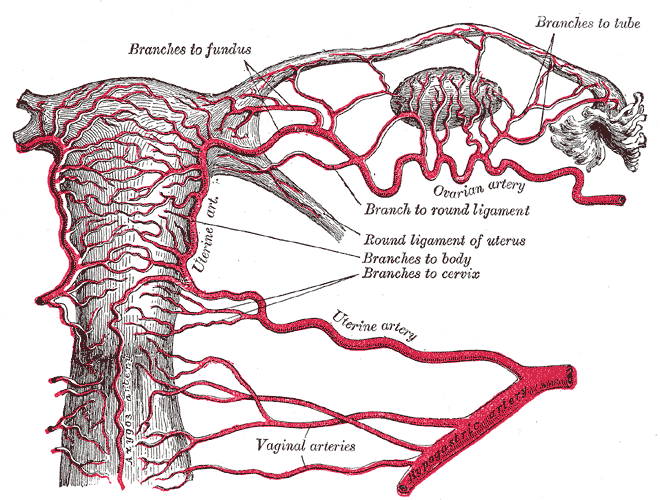Dysfunctional uterine bleeding pathophysiology
|
Dysfunctional uterine bleeding Microchapters |
|
Differentiating Dysfunctional uterine bleeding from other Diseases |
|---|
|
Diagnosis |
|
Treatment |
|
Case Studies |
|
Dysfunctional uterine bleeding pathophysiology On the Web |
|
American Roentgen Ray Society Images of Dysfunctional uterine bleeding pathophysiology |
|
Directions to Hospitals Treating Dysfunctional uterine bleeding |
|
Risk calculators and risk factors for Dysfunctional uterine bleeding pathophysiology |
Editor-In-Chief: C. Michael Gibson, M.S., M.D. [1]; Associate Editor(s)-in-Chief: Arooj Naz, M.B.B.S
Overview
Dysfunctional uterine bleeding is a condition that affects many women worldwide, especially because it has a wide range of underlying causes. Bleeding can be acute or chronic. By understanding the pathophysiology of the causative conditions, one can understand the cause of dysfunctional uterine bleeding. These include polyps, adenomyosis, leiomyoma, malignancy or hyperplasia, coagulopathies, ovulatory dysfunction, endometrial disorders and iatrogenic causes. In ovulatory causes, unopposed estrogen and progesterone result in continued thickening and proliferation of the endometrium. Along with the effects of these hormones, hypoxia, inflammation and vasoconstriction result in shedding and subsequent scarring.
Pathophysiology
Dysfunctional uterine bleeding can be classified into acute and chronic causes.[1]
- Acute Dysfunctional uterine bleeding: Acute bleeding can develop in one of two ways. Bleeding can develop acutely on which immediate intervention is required to prevent excessive blood loss, or it can be imposed upon chronic uterine bleeding. The latter often refers to menstrual irregularities that developed of 6 months or longer.
- Chronic Dysfunctional uterine bleeding
At the end of the menstrual cycle, progesterone levels fall significantly leading to a breakdown of the functional layer of the endometrium. This leads to the phenomenon known as the menstrual cycle. This cycle can become irregular due to several causes, especially any derangements in the architectural structure of the endometrium. Common underlying causes include polyps, adenomyosis, leiomyoma, malignancy or hyperplasia, coagulopathies, ovulatory dysfunction, endometrial disorders and iatrogenic causes. DUB that is due to underlying ovulatory causes occurs due to defects in local endometrial functions whereas anovulatory is often due to systemic disorders, endocrine or neurological imbalances. By understanding the pathophysiology of these conditions, one can understand the cause of dysfunctional uterine bleeding:[2]
| Condition causing DUB | Pathophysiology |
|---|---|
| Polyps | Endometrial polyps are overgrowths of endometrial tissue. They can vary in size and eventually result in obstruction to the endometrial outflow path[3] which may lead to unexpected bleeding |
| Adenomyosis | Adenomyosis is characterized by the presence of ectopic endometrial tissue (the inner lining of the uterus) within the myometrium (the thick, muscular layer of the uterus). Although the pathophysiology is not well understood, the basic Fibroblast Growth Factor receptor/ligand system has shown to be upregulated. Hormones such as estrogen and progesterone as well as oxytocin, FSH, and prolactin also contribute to the pathogenesis of the disease by causing tissue proliferation |
| Leiomyoma | Also referred to as fibroids, leiomyoma are tumours of benign origin made up primarily of smooth muscle and fibrous connective tissue. They can presents as serosal, submucosal, subserosal or pedunculated masses. Leiomyoma has been linked to underlying genetic mutations including translocations (12;14)(q14-q15;q23–24), deletions (7)(q22q32) and rearrangements involving 6p21, 10q, trisomy 12 |
| Malignancy and hyperplasia | Typical proliferation due to underlying hyperplasia or malignancy of the endometrium is an important cause of dysfunctional endometrial bleeding and warrants further investigations, especially in older women |
| Coagulopathies | Conditions that lead to defective blood clotting, such as Von Willebrand disease, may contribute to DUB. In vWF deficiency, there is a defect in the platelet plug formation that results in a defective platelet adhesion and clot formation |
| Ovulatory | Ovulatory causes are due to unopposed effects of estrogen, which result in continued thickening and proliferation of the endometrium. When there is an imbalance between estrogen and progesterone hormone levels, heavy menstrual bleeding, as well as an alteration in bleeding patterns and frequency, are noted. Although drugs are considered an anovulatory cause, those drugs that affect dopamine levels interfere with the hypothalamic axis and also contribute to DUB. Although not entirely understood, endometrial bleeding may be due to hypoxia, inflammation and vasoconstriction [4] that play a role in shedding and subsequent scarring [5] |
| Endometriosis | The Sampson theory of retrograde menstruation, the coelomic metaplasia theory, and the lymphatic and vascular dissemination theory explain the implantation and invasion of the endometrial tissue outside the uterine cavity. Immunologic factors and genetic factors are also thought to play a role in the pathogenesis of endometriosis [6] |
| Iatrogenic | Iatrogenic causes refer to inadvertent injuries induced by my physicians. Such causes include unopposed and continuous exposure to estrogen and progesterone therapy, as is seen with contraceptive medications, GnRH agonists, and SERMs.[7] |
Blood supply of Endometrium
The ovarian artery arises from the aorta and descends into the retroperitoneum alongside the gonadal vein and ureter. Eventually, it anastomoses with the ovarian branch of the uterine artery at the uterus. Vasoconstriction affects these vessels may contribute to DUB.

References
- ↑ "StatPearls". 2022. PMID 30422508.
- ↑ Munro MG (2001). "Dysfunctional uterine bleeding: advances in diagnosis and treatment". Curr Opin Obstet Gynecol. 13 (5): 475–89. doi:10.1097/00001703-200110000-00006. PMID 11547028.
- ↑ "StatPearls". 2022. PMID 32491756 Check
|pmid=value (help). - ↑ Livingstone M, Fraser IS (2002). "Mechanisms of abnormal uterine bleeding". Hum Reprod Update. 8 (1): 60–7. doi:10.1093/humupd/8.1.60. PMID 11866241.
- ↑ Whitaker L, Critchley HO (2016). "Abnormal uterine bleeding". Best Pract Res Clin Obstet Gynaecol. 34: 54–65. doi:10.1016/j.bpobgyn.2015.11.012. PMC 4970656. PMID 26803558.
- ↑ Bulun, Serdar E. (2009). "Endometriosis". New England Journal of Medicine. 360 (3): 268–279. doi:10.1056/NEJMra0804690. ISSN 0028-4793.
- ↑ Whitaker L, Critchley HO (2016). "Abnormal uterine bleeding". Best Pract Res Clin Obstet Gynaecol. 34: 54–65. doi:10.1016/j.bpobgyn.2015.11.012. PMC 4970656. PMID 26803558.